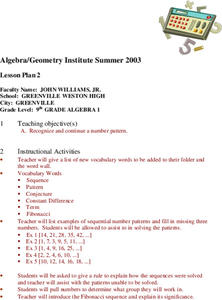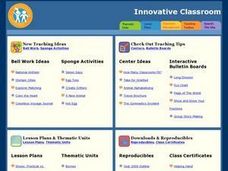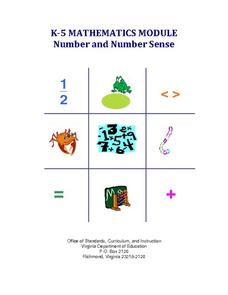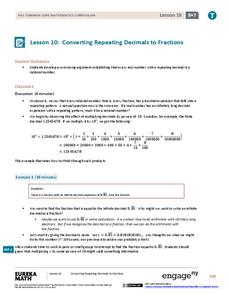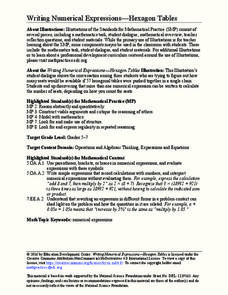Curated OER
Patterns and Sequences
Ninth graders examine sequential number patterns and the Fibonacci sequence. Given number patterns, they determine the next number in a sequence. Students develop their own number patterns and exchange them with another to be solved.
Curated OER
Number Patterns
Fourth graders recognize patterns in a series of numbers and symbols. They also make their own patterns and explain them in writing. After practicing with a worksheet imbedded in this plan, 4th graders attempt to make up their own number...
Curated OER
Number Patterns Challenge
In this number patterns worksheet, students practice recognizing patterns. Students determine the number pattern and complete the pattern by inserting the last two numbers. There are ten problems in all, and an answer sheet is included.
Curated OER
Number Patterns Challenge
In this number patterns worksheet, learners practice recognizing patterns. Students determine the number pattern and complete the pattern by inserting the last two numbers. There are ten problems in all, and an answer sheet is included.
Curated OER
Number Patterns Challenge
In this number patterns worksheet, students practice recognizing patterns. Students determine the number pattern and complete the pattern by inserting the last two numbers. There are ten problems in all, and an answer sheet is included.
Pennsylvania Department of Education
Extending Pattern Understandings
Students use shapes and manipulatives to demonstrate patterns. In this patterns lesson plan, students also break up patterns to identify a pattern unit.
Curated OER
Prime Time
Students participate in activities to investigate properties of numbers. They identify prime and composite numbers and determine the patterns associated with these numbers. They answer questions associated with each activity.
Curated OER
Patterns in Pascal's Triangle
Students examine the patterns that exist in Pascal's Triangle. They explore multiples and factors. Sudents use an applet to create and color the multiples in Pascal's Triangle.
Curated OER
Macaroni Pattern Necklaces
Pupils create a macaroni necklace based on a pattern given them by the instructor. In this reinforcement lesson, students are given a complex pattern and using a letter key. They must recreate the patten using colored macaroni strung...
Curated OER
Linear Patterns in Data
Eighth graders extend their learning of graphing linear equations and are introduced to connecting patterns in tables and graphs to represent algebraic representations. They then determine patterns and extrapolate information from these...
Curated OER
Practice With Patterns
In this pattern worksheet, students explore sequence of numbers. They identify the next number in a sequence. This one-page worksheet contains 30 problems. Students may check their answers online.
Curated OER
Subtraction With Negative Results
In this subtraction worksheet, students solve 80 problems in which a single digit number is subtracted from another number that is smaller. The answers will be negative numbers.
Curated OER
Number Patterns: Triangular & Square Numbers
Students explore the patterns found in triangular and square numbers. In this number pattern lesson, students complete a worksheet exploring the relationship between triangular numbers and square numbers.
Curated OER
Patterning With Zero
For this subtraction worksheet, students determine the pattern for the worksheet. Students complete the worksheet by filling in the missing numbers in the subtraction problems and them determine what the the last two problems should be.
San Jose Unified School District
Multiplication Chart
Looking to support your young mathematicians with mastering their multiplication facts? Then this set of multiplication charts is a great place to start, allowing children to visualize the the relationships between factors and multiples.
Curated OER
Hands On: Multiplication Patterns with 10, 100, and 1,000
In this multiplication patterns worksheet, students find the products for each multiplication word problem using basic multiplication facts and finding the patterns. The patterns use the numbers 10, 100, and 1,000.
Concord Consortium
Last Digit Arithmetic
Mathematics involves a study of patterns. The exploratory lesson has learners consider the addition pattern in different sets of numbers. Each set has a different pattern that pupils describe mathematically. The patterns involve both...
One Billion
Math, Age 3-5
Jump start children's math education with this fun basic skills resource. Offering dozens of different touch-and-swipe activities with colorful graphics, this program is perfect for all young learners.
Curated OER
K-5 Mathematics Module: Number and Number Sense
Reinforce number sense with a collection of math lessons for kindergarteners through fifth graders. Young mathematicians take part in hands-on activities, learning games, and complete skills-based worksheets to enhance proficiency in...
EngageNY
Converting Repeating Decimals to Fractions
Develop a process with your classes for converting repeating decimals to fractions. Through this process, pupils understand that any repeating decimal can be written as a fraction. The 10th lesson in this 25-part module helps reinforce...
Public Schools of North Carolina
Math Stars: A Problem-Solving Newsletter Grade 2
Develop the problem solving skills of your young learners with this collection of math newsletters. Covering a variety of topics ranging from simple arithmetic and number sense to symmetry and graphing, these worksheets offer a nice...
Los Angeles County Office of Education
Assessment for the California Mathematics Standards Grade 3
Assess scholars' knowledge with a 22-page assessment that covers place value, patterns, probability, estimation, measurement, geometric figures; and their ability to add, subtract, multiply and divide proficiently.
Education Development Center
Writing Numerical Expressions—Hexagon Tables
Explore a basic pattern to practice writing expressions. In collaborative groups, learners examine a contextual pattern and write an expression to model it. The task encourages groups to describe the pattern in multiple ways.
Virginia Department of Education
Integers: Addition and Subtraction
Young mathematicians construct their own understanding of integers with an inquiry-based math lesson. Using colored chips to represent positive and negative numbers, children model a series of addition and subtraction problems as they...


